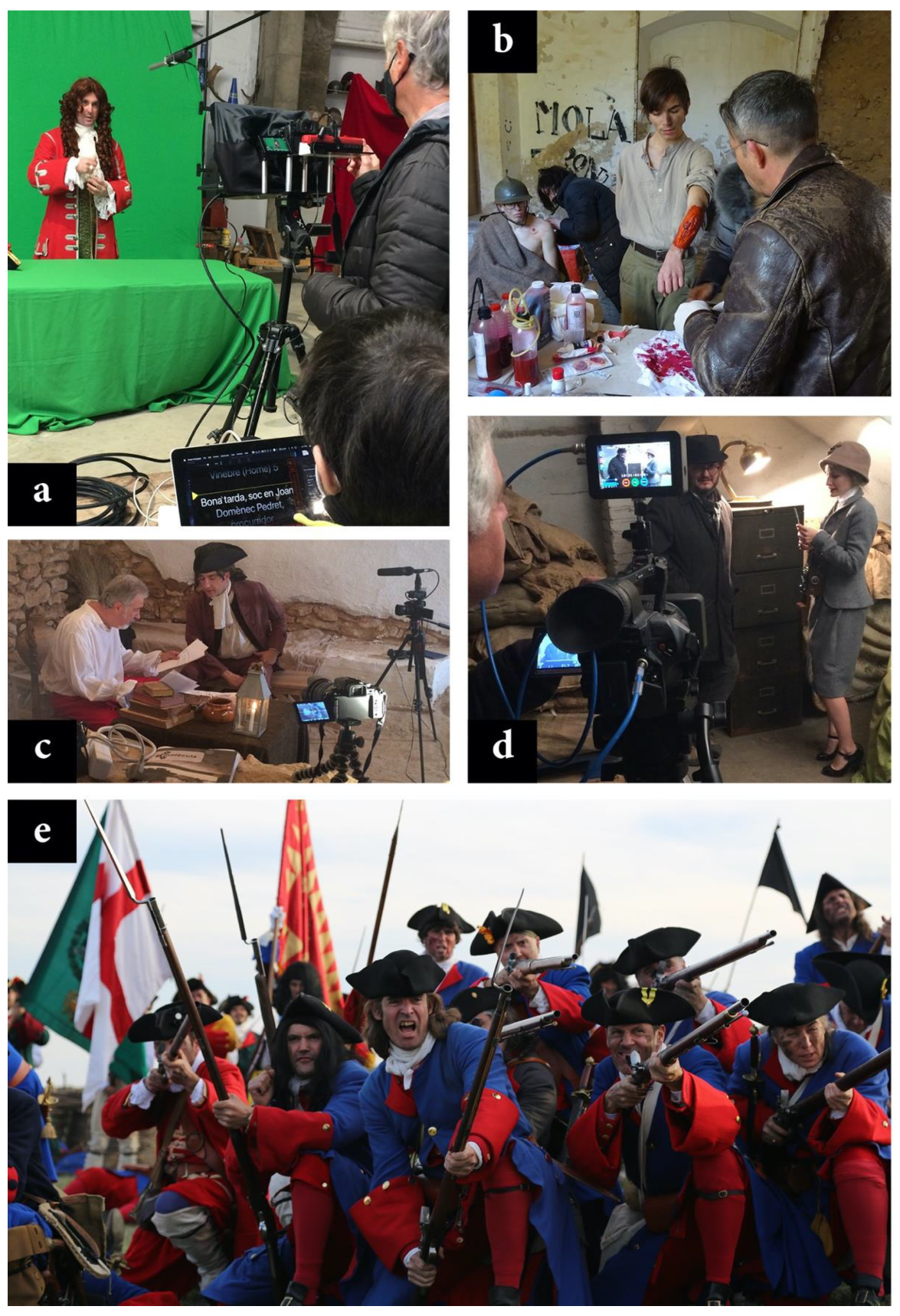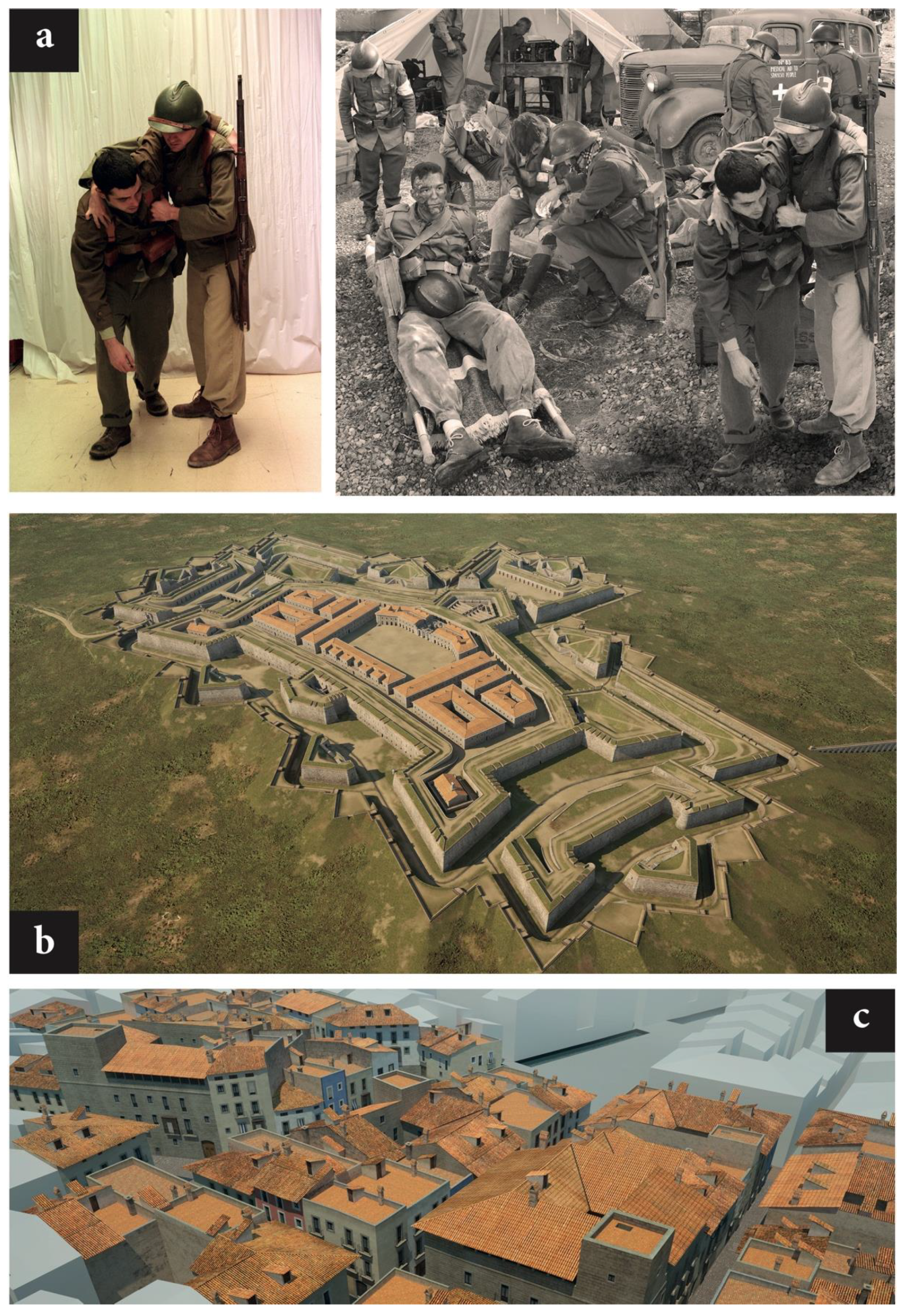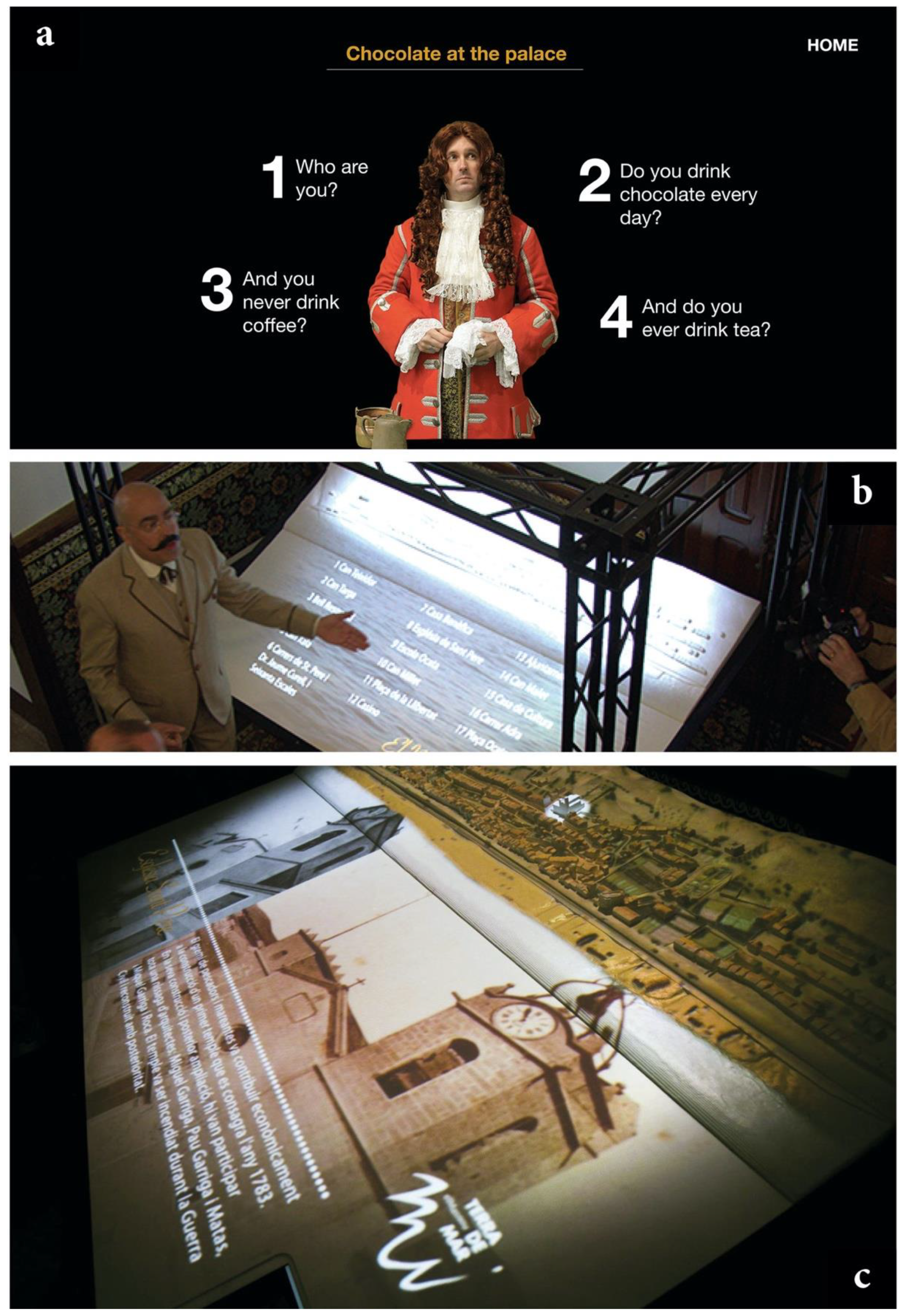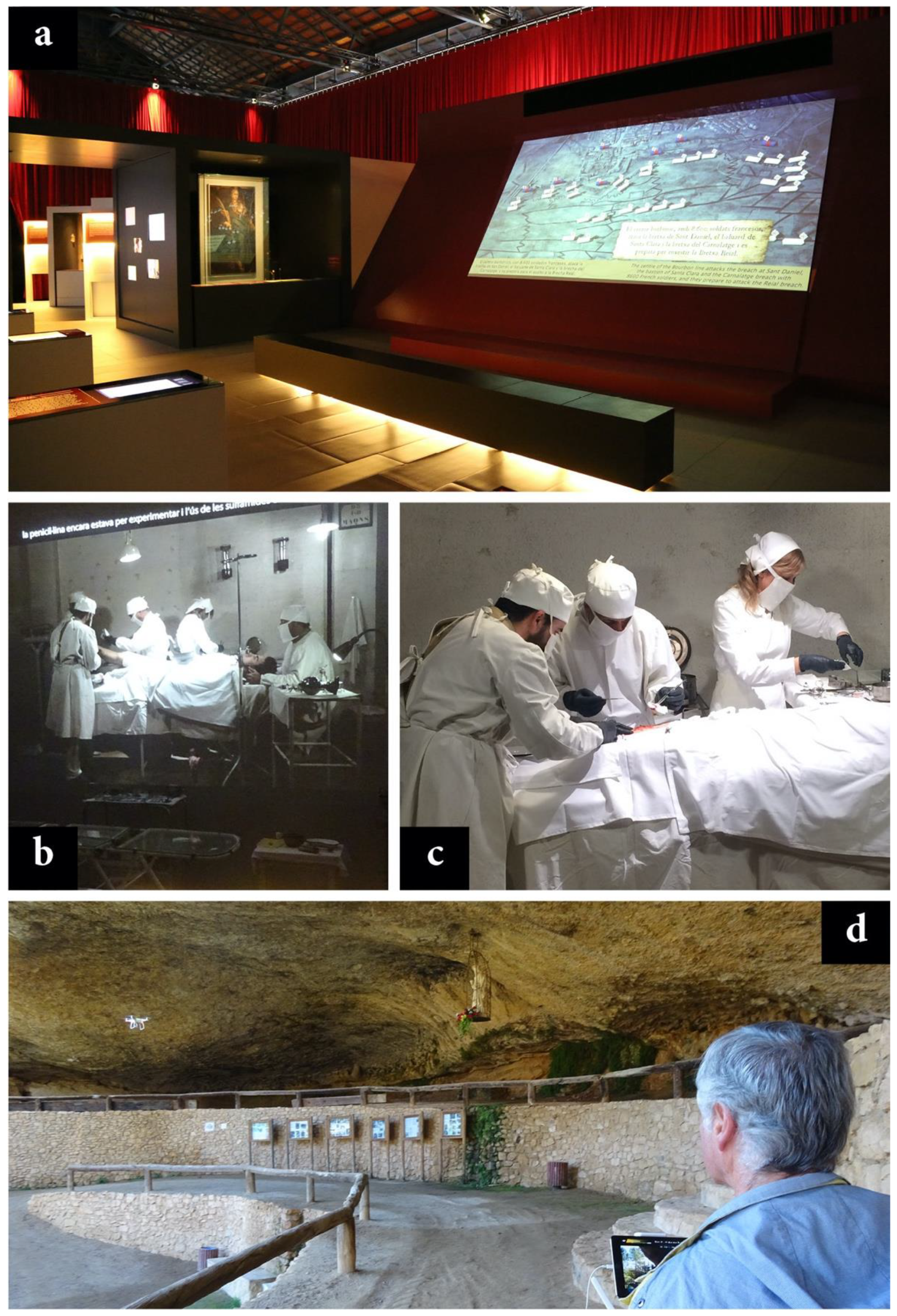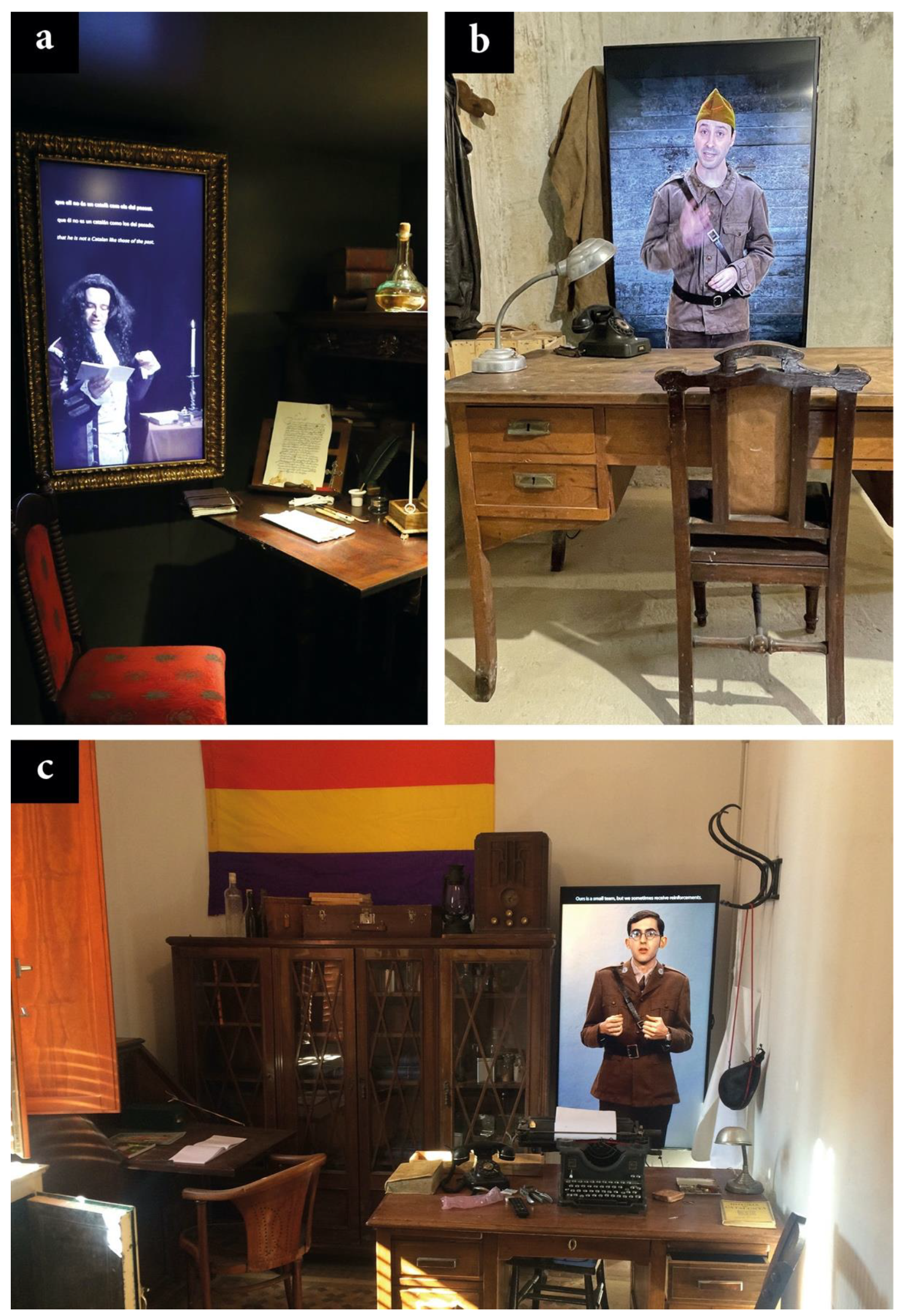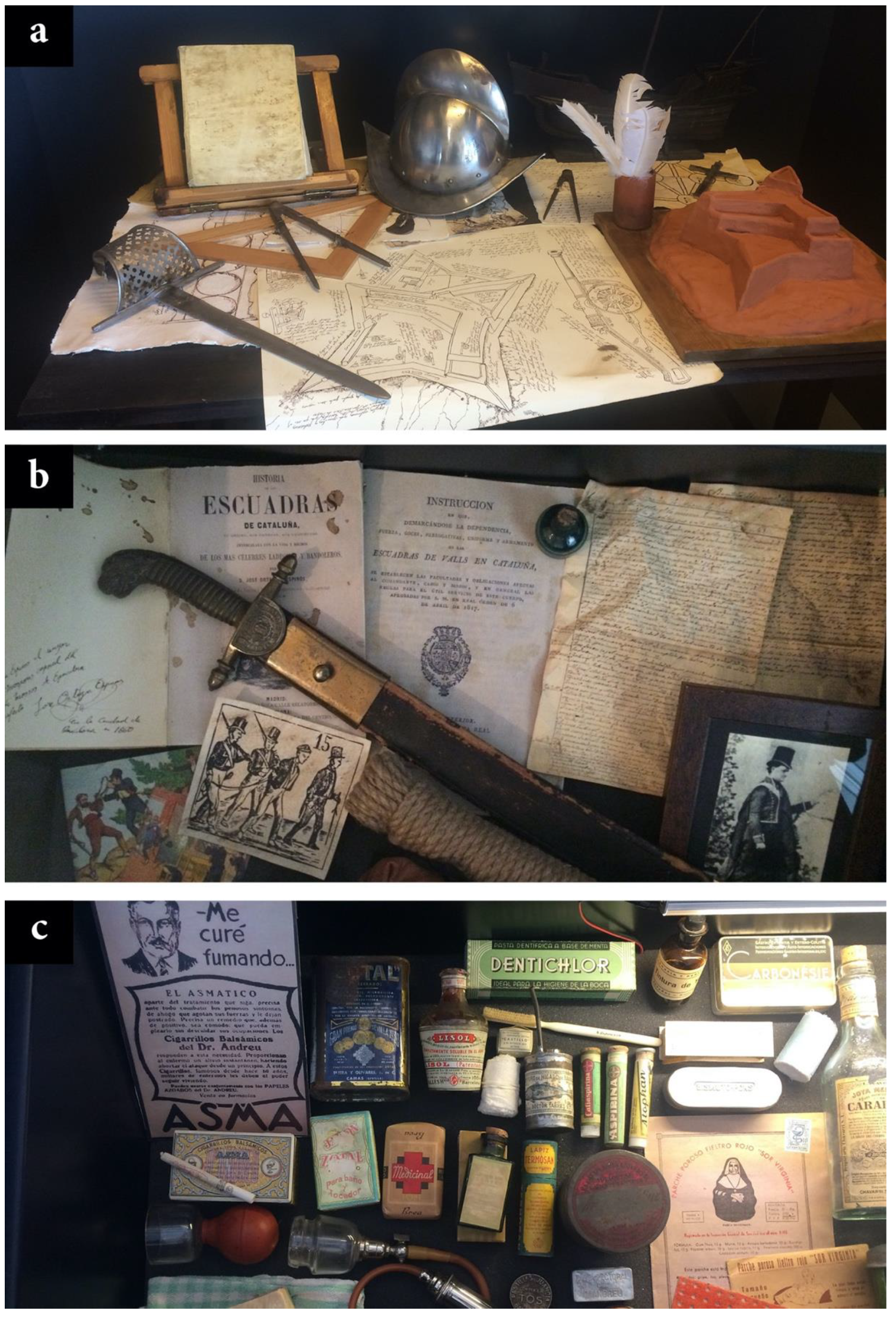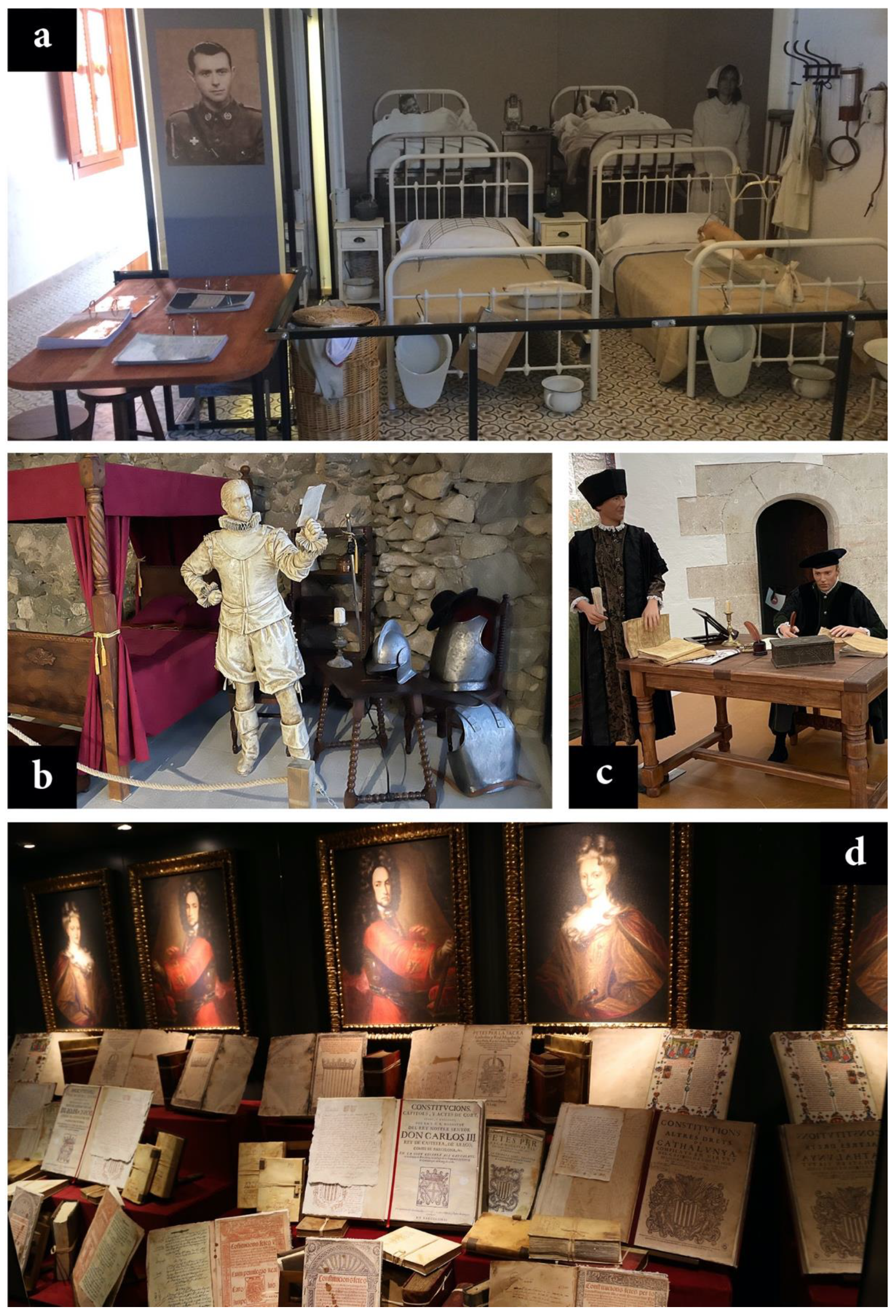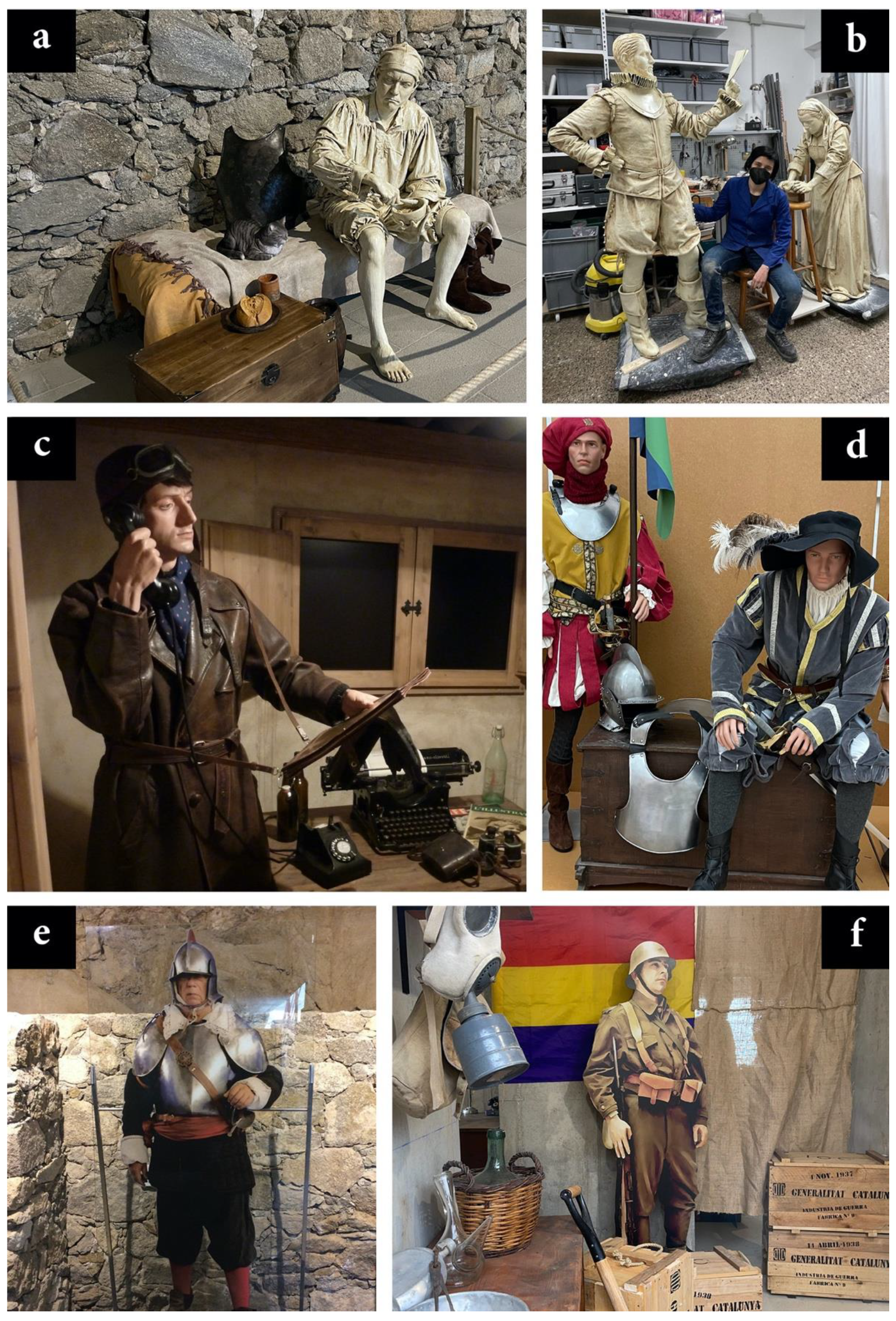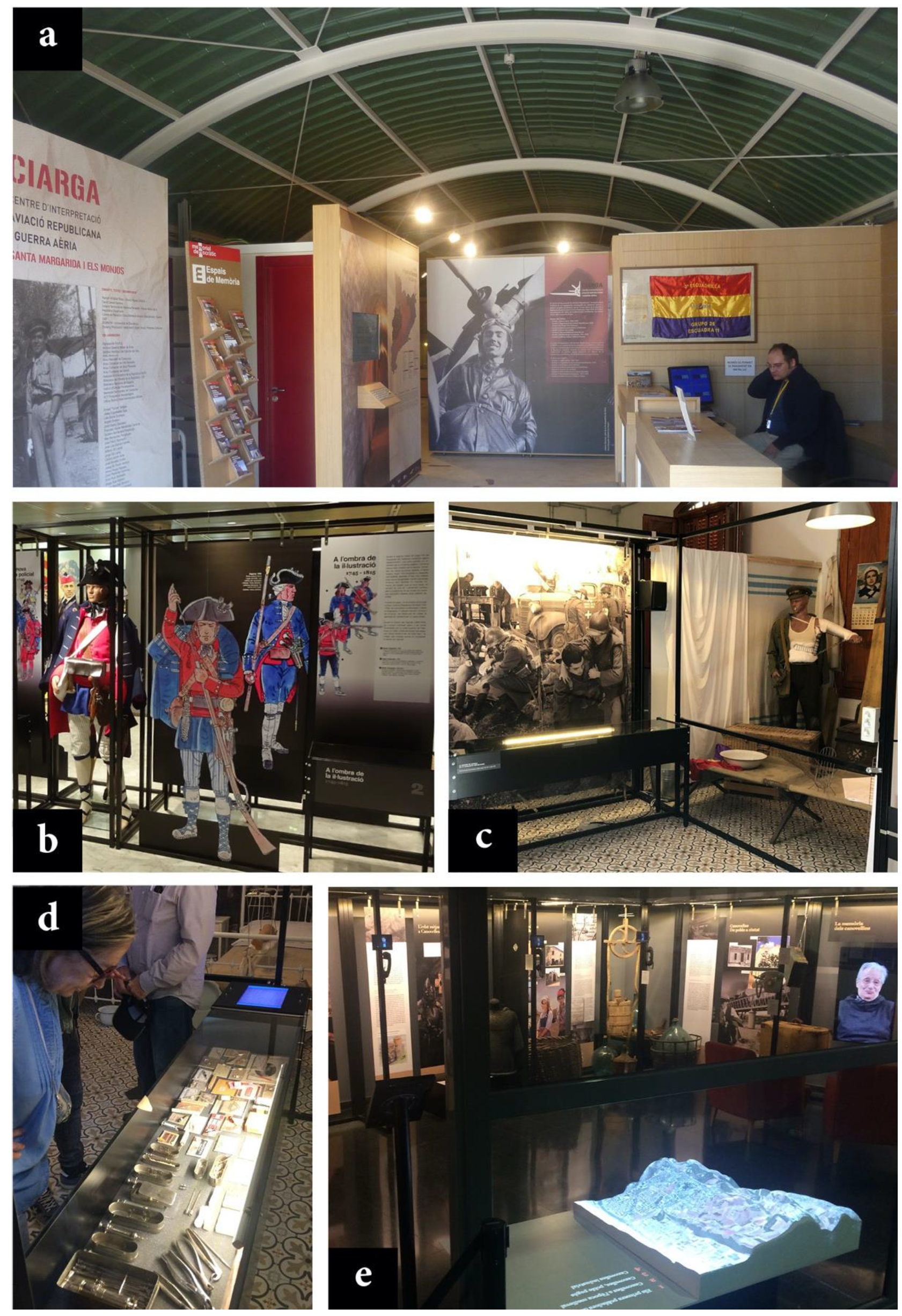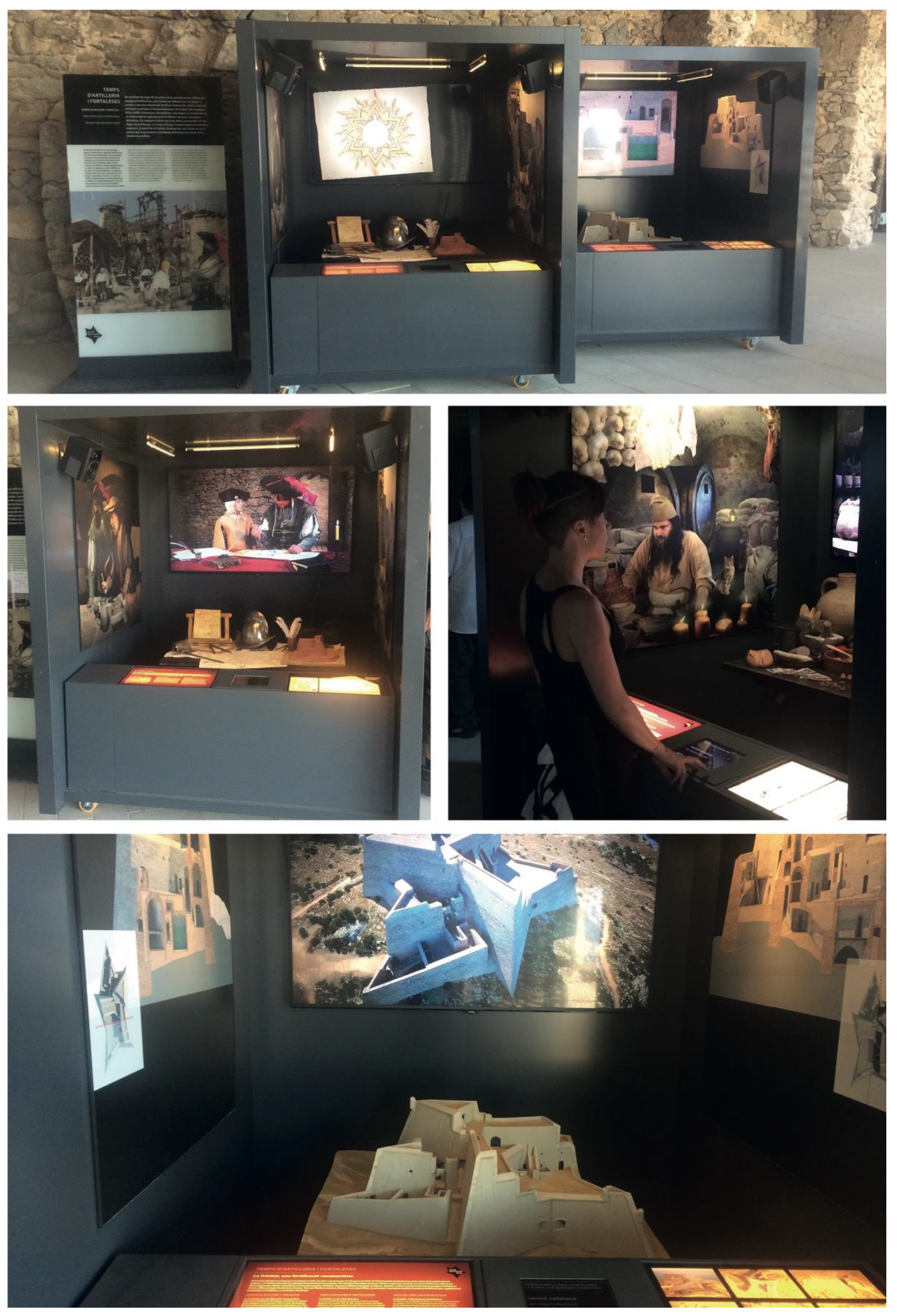1. Introduction
1.1. Historical Heritage and Social Museography
The concept of “historical heritage” is polysemic and undergoes a continuous process of construction and deconstruction. The concept of heritage is understood differently from the point of view of history, archaeology, history of art, archives, etc. We will not enter the discussion about heritage, starting from the basis that it is an open concept and under construction, object, and subject of our relationship with the past. Our daily life (knowledge, beliefs, traditions, organizations, customs, food, activities, technologies, artifacts, cultural preferences, etc.) is built on an infinity of facts and decisions made in the past. The power of the past (little visible and little questioned) decides almost everything. Knowing how to use and learning to know history implies a power that can be reapplied to each one situation of daily life, whether individual or collective. Knowledge of the past is one pillar of civic empowerment. Although our historicity cannot always be perceived, heritage is the evidence of history. Heritage comprises components from the past that we recognize in the present; they are survivals we identify and give value to. In this sense, heritage (understood as identified present history) is one bridge that allows us to decide about the social, political, scientific, humanistic, artistic, technological values, etc., that have built our societies. Heritage is one key that can allow us to better understand the submerged parts of the iceberg of our culture. This helps us to better understand the imagination of our societies [
1]. Heritage, in a broad sense, is the only thing observable in history and, therefore, allows us a scientific approach to the past. This is very important in teaching environments since history is often approached with more ideological than non-scientific criteria. However, the views of the past that we make from the present depend on the worldviews of each moment. The perception of the past is neither linear nor uniform. People from a certain historical period can rediscover and be interested in certain heritage environments, different from those that aroused attention and consideration at other times. The assessment (or not) of the historical-archaeological heritage is a determining factor in the ideological construction of a society, and, in this sense, its knowledge is significant in the construction of a quality citizenry aware of its limits [
2,
3].
In the last decades of the 20th century, post-industrial processes incorporated knowledge and culture into economic dynamics. During the industrial revolution, heritage had a leading role focused on its ideological dimension, reinforcing the nation-state and with an exclusive orientation for a bourgeois public. In the post-industrial context, interest in heritage experiences a Copernican turn through democratizing access to culture. Knowledge about the societies themselves, about their geophysical environment, as well as about other societies, about their present and their past, was valued. The historical heritage gained an interesting position as an informative agent of civilization heritage, as a present past, as a source of aesthetic and educational experiences, and as a royal power. Heritage was integrated into the economy as an object of consumption, and the culture and communication industries put into circulation the most diverse products of the past. Tourism facilitated the direct contemplation of the following emblematic heritage resources of the planet: museums, monuments, cultural complexes, etc.
A new, more democratic imaginary of heritage, and with the appearance of emerging heritage, complemented this dynamic of change. Until the middle of the 20th century, the idea of heritage was limited to architectural or artistic works linked to those of the powerful people of other times. In this new context, the concept of heritage was democratized and extended to any significant aspect of the past. Old factories, old locomotives, bridges, workers’ houses, sewers, ships, planes, battlefields, historical landscapes, etc., became objects of interest and musealization because anything or human achievement has interest to humans [
4,
5].
In the post-industrial context, and up to now, the growth of the following social consumption of history has increased: museums, interpretation centers, eco-museums, visitor centers, routes, monuments, virtual museography, augmented reality, proposals, and information on the internet [
6], experimental archaeology and re-enactment activities, educational workshops, historical or pseudo-historical shows, and also, logically, movies, television series, historical novels, collections, toys, games of all kinds, and articles diverse fashion trends [
7]. Millions of people try to access the power of history, which has generated a greater appreciation of the didactic factor.
In this context, the museographic proposals had to face very general audiences who requested intermediation actions to better understand historical-archaeological heritage assets, fragmented, and out of context. Access to knowledge requires clear, educational, and playful presentation programs. New techniques and technologies try to put the power of history within the reach of the people.
By definition, museums are non-formal teaching-learning spaces where knowledge is communicated, and emotions are experienced from objects, structures, stories, images, etc. From an epistemological point of view, until now, this process has been carried out intuitively. There has been limited reflection on museographic communication from the academic environments of the sciences of the past. From museology and museography (disciplines with an unclear epistemology), the didactic factor has been neglected, promoting a more conservative will that is not very innovative. However, from different currents and movements, museographic proposals have been made possible that affect the understanding of facts, concepts, conceptual systems, artifacts, and places of the past. In this context, we must understand the irruption of emerging movements such as the “interpretation of heritage” [
8,
9]; a discipline that grew up in the shelter of the great North American natural parks and that also became concerned with historical settings.
Interpretation has many professionals with publications, recognized lines of research, and evaluation systems [
10,
11,
12]. Movements arose based on the experience of the Exploratorium center in San Francisco [
13], which opted for an interactive museography. This proposal spread. Many British historical-archaeological museums incorporated interactive artifacts during the 1980s. The first national history museum that incorporated didactic and interactive museography criteria was the Museum of the History of Catalonia in Barcelona, inaugurated in 1996 [
14]. In 2006, someone restructured the German History Museum in Berlin. The rise of interactive museography expanded in parallel with the appearance of a didactic museography that facilitated the interpretation of historical and archaeological contexts. These proposals were linked with the advancement of virtual reality, augmented reality, and virtual museography and entered interaction with the relaunch of eco-museums and historical-archaeological parks that developed border experiences with experimental archaeology and re-enactment. This new and rich universe pointed to cooperation strategies in a civic key in tune with the Public Archaeology and Public History movements [
15,
16,
17].
On an international scale, these dynamics were reinforced and merged at the beginning of the 21st century. Archaeology and history museums, monumental spaces, monuments, and historical archaeological spaces, interpretation centers on the most diverse aspects of the past…, began a new stage characterized by the survival of traditional exhibition techniques and incorporating participatory, interactive, or immersive proposals. A social and sustainable museography was called for, which would make content of all kinds available to broad sectors of the population, in all kinds of places, and deal with all kinds of topics. A comprehensive museography to satisfy the growing interest in heritage that was no longer limited to large installations but included local micro-initiatives that strived to open new horizons in cultural and market spaces.
1.2. New Demands, New Complexities, New Problems
At the beginning of the 21st century, historical-themed museography was subsidiary to various traditions. They recognized the need to promote intermediation strategies to facilitate the understanding of the museographic proposal. However, new problems appeared, and new horizons were defined. In this period, the creation of great history museums at the European level (and even worldwide) slowed down. At the end of the 20th century and during the first decade of the 21st century, very powerful museums of a general nature were created, such as the German History Museum in Berlin (2006) or the Museu d’Història de Catalunya in Barcelona (1996). With more contemporary themes, the Museum of the Great Patriotic War in Moscow (1995), the Caen-Normandie memorial (1988), and the Museum of the Warsaw Uprising (2004) were inaugurated. Other facilities inaugurated were the following: the Panorama 1453 in Istanbul (2008) and the MUCEM in Marseille (2013). During the second decade of the 21st century, the rate of creation of large museums with historical themes decreased. The following important museographies were inaugurated during this period: the Gallipoli exhibition at the Te Papa Museum in Wellington (New Zealand) (2015), the Musée de la Romanite de Nîmes (2018), and the spectacular installations in the Lascaux IV caves (2017), and Chauvet (2015) in France.
The slowdown in the production of large museum interventions occurred in parallel to the emergence of hundreds of initiatives (dispersed throughout the territory and of discrete dimensions and costs) [
18] that proliferated in small-town neighborhoods. These were interventions that promoted aspects of local history that, in many cases, were interesting due to their uniqueness, originality, or even their spectacular nature. The time of the “dinosaur museums”, dependent on the large investments of the states, would have evolved into a period of “small rodents”, museums symbiotic with the territory and with much more effective expectations of sustainability, incidence, and integration into their environments. An old intensive model gave way to a new, more balanced heritage culture on the territory.
The typology of these interventions was very diverse and included exhibitions, interpretation centers, routes, landscapes, musealization of places, memory spaces, etc. These were modest interventions, with tight budgets, carried out by regional or municipal administrations. They intended to reinforce or expand local economic expectations with the generation of complementary activities based on cultural industries and tourism. In many cases, the initiatives also responded to cultural concerns and the social will to promote civic cohesion. In any case, these facilities offered the possibility of rethinking museographic strategies to respond to a growing demand for musealization. The research and innovation activities of the DIDPATRI research group (Heritage Didactics) of the University of Barcelona were embedded in this process, developing various projects between 2010 and 2021. These projects aimed to generate intervention models.
The DIDPATRI research group already had extensive experience in the field of museography. Its researchers designed or directed museographies such as those of the Museu d’Historia de Catalunya (1996) [
19]; the musealization of the protohistoric site of Alorda Park, in Calafell (1996) [
20], or the musealization of the Renaissance walls of Dalt Vila in Ibiza (2002). Now it was about facing a new period, with new ideas to meet new demands. The debates with the political environments and professional social networks allowed us to identify what the problems were and what the working hypotheses were.
The additional problems established the following points:
- (a)
The need to delve into a comprehensive and didactic museography aimed at a wide spectrum of the public, and that would allow effective intermediation between the public and the objects, contents, and concepts to be shown;
- (b)
The need to link museum heritage projects to civil society. This implies designing cooperation formulas and participatory strategies with citizens to sustain, develop, and support heritage projects;
- (c)
The need to develop economically sustainable projects that are congruent with the characteristics of the territory and with the possibilities of maintenance. Sustainable projects, also in terms of economic profitability and training of quality citizenship;
- (d)
The need to develop a museography appropriate to the needs of understanding. The museography must be functional and resistant; the contents worked on (iconographic, cartographic, textual…) must be able to be reapplied in different supports or in another complementary museography;
- (e)
The need to promote a creative museography capable of surprising, interesting, or moving. The spectacular nature and uniqueness of the approaches must compensate for the limitations imposed by economic sustainability;
- (f)
The need to propose interventions to sustain and safeguard heritage and to increase the protection of related heritage; weaving meshes that help define new horizons of interaction.
For the development of the research processes, the demands and problems detected required a clear approach regarding the objectives and working hypotheses.
1.3. General and Specific Objectives, Work Hypotheses
The scientific, technological, and didactic objectives considered transversally in the metaproject of social museography have been raised in a series of general objectives and specific objectives linked to projects.
1.3.1. General Objectives
- —
Regarding conceptual design:
Design museographic projects and interventions in the area of historical heritage in terms of “fragmentary engineering”, integrating the contributions of the most diverse museological, museographic, and heritage intervention currents.
- —
Regarding sustainability:
- —
Regarding territorial museography:
- —
Regarding techniques, technologies and resources:
- —
Regarding iconography:
- —
Regarding citizen participation:
1.3.2. Specific Objectives
- —
Regarding conceptual design:
- 1.
Add and integrate in the projects, in which it is pertinent, the contributions of the interpretation of the heritage; interactive museography; didactic museography; audiovisual museography; digital and computer museography; simulation; experimental archaeology, historical recreation;
- 2.
Consider, in the different projects, that the understanding of the musealization object (for broad recipient horizons) constitutes a central objective.
- —
Regarding sustainability:
- 3.
Establish criteria of proportionality between economic costs of museographic resources and duration, reapplication, and comprehension capacity;
- 4.
Develop kilometer zero museographies taking advantage of resources, professionals, and materials from the territory;
- 5.
Use reusable artifacts and non-polluting recyclable materials in museography;
- 6.
Propose a museography (satellite) that may have possibilities of reapplication or projection in different communication spaces (web, audiovisual, publications, mobile telephony, apps, 3D printing, etc.)
- —
Regarding territorial museography:
- 7.
Take advantage of the heritage resources of the territory in the service of sustainable development;
- 8.
Propose networks and synergies between the heritage resources of a territory. Take full advantage of the assets of a territory in terms of materials, trades, and technicians in the production of museography;
- 9.
Design centers or interventions all open or in situ to comprehensively enhance the heritage resources of a territory;
- 10.
Define the design processes in a participatory key to adjust the interventions to the demands of the territory.
- —
Regarding techniques, technologies, and resources:
- 11.
Especially consider the possible options based on the use of basic CGI (Computed-Generated Imagery) software, to build images of the past, conceived as mediation artifacts, suitable for contributing to the interpretation of various types of heritage environments, and reapplicable in different types of supports (museum artifacts, publications, audiovisuals, apps…), and environments (education, cultural industries, cultural tourism, edutainment…);
- 12.
Establish the possible protocols in terms of design processes and elements to be integrated into the different models (depending on the object of knowledge) and uses.
- —
As for iconography
- 13.
Assess the possibilities of generating images from basic CGI (computed-generated imagery) software, to elaborate perceptions of the past;
- 14.
Consider iconography as an intermediary strategy, useful for facilitating the understanding of tangible or intangible, and fragmentary or decontextualized historical-archaeological spaces and heritage.
- —
Regarding citizen participation:
- 15.
Add synergies of the territory in the enhancement of heritage and establish alliances with civil society organizations and local organizations for a sustainable enjoyment of heritage;
- 16.
Define characteristics and uses of museological and museographic proposals in the heritage environment in collaboration with professionals involved in the management or use of heritage spaces (conservators, technicians, teachers, guides, businessmen, political managers…);
- 17.
Define participatory design processes to adjust research to social demands.
1.3.3. Work Hypotheses
The general intervention hypotheses considered the need to develop new postulates of social museography (which would redouble the commitment between research and society) from a perspective of scientific and civic development. We understood that social museography could influence the formation of quality citizenship.
We started with the hypothesis that the design of a new social museography should integrate the contributions made by different currents and experiences (from the showcase to smartphones) in the key to “fragmentary engineering” of the concept close to Popper [
21]. This implied considering the exhibition systems of traditional museography (showcases, panels, texts, scenography…) but also the contributions of mechanical interactive museography, interactive computer museography, audiovisual and iconographic resources, as well as emerging digital museography. (Web, virtual reality, augmented reality, QR codes, Apps…) [
22,
23]. From these options, understandable, attractive, suggestive products should be generated, capable of stimulating emotions and civic values. Regarding the costs, we started on the basis that there was no directly proportional relationship between the costs and the comprehensibility of an exhibition. Nothing prevented a proposal with adjusted costs from having excellent results from the point of view of the understanding of the contents or the development of emotions. We valued the aesthetic dimension (as axiological), but we did not define it. We considered it essential to generate actionable and understandable content. We started with the hypothesis that what was important in a museographic proposal was not its axiological aesthetic dimension. We considered its didactic dimension to be indispensable, the ability to make past contexts understandable. This didactic aspect responded to an empirical logic (more or less understandable) that could be measured by scientific criteria.
We estimated among the starting hypotheses that museography was not independent of the previous processes or of the dynamics of socialization. We should also consider participatory strategies linked to interpretation, historical recreation [
24,
25], experimental archaeology, gamification, etc. We understood we should consider the proposals for social museography from the contexts of Public Archaeology and Public History; these currents were the ones that best established a symbiotic horizon between science and civility.
In short, we established as the main hypothesis that it could generate a new social and sustainable museographic culture. This had to be linked to the needs and demands of the territory, and it had to be economically viable and sustainable. Finally, it had to put the emphasis on understanding and that it affected the generation of quality citizenship.
We developed the research and innovation processes from the following specific museum projects that served as a research and innovation bank: the Republican Aviation and Air War Interpretation Center, CIARGA, and Molar Interpretation Center. A hospital in the Battle of the Ebro, Exhibition “Done Perficiam” of the Born of Barcelona; Musealization of the Trinitat fortress (Roses), Mossos d’Esquadra Uniformology Exhibition, Cunit Pill Box, Heritage of the Medieval City of La Seu d’Urgell… The set of these projects configured a metaproject, a project of projects. In all of them, we tested options from a social museography perspective.
2. Materials and Methods
2.1. Museographic Productions
The research and innovation processes developed by the DIDPATRI research group of the University of Barcelona (2010–2021 period) maintained a line of research specific to the environment of social museography. Four cases were the focus of the work, where the group designed the executive project. The cases worked were the following:
- —
CIARGA. “Republican Aviation and Air War Interpretation Center”. (els Monjos Tarragona) (2010–2011);
- —
“Donec Perficiam. The siege of Barcelona 1713–1714”. (Cultural Center of el Born. Barcelona) (2013–2015);
- —
“Molar Interpretation Center. A Hospital in the Battle of the Ebro” (el Molar Tarragona) (2017–2019);
- —
Trinity fortress. (Roses, 2017–2020). A Renaissance fortification.
During this period, the group also carried out the other following interventions: Cultural revitalization project for the medieval city of La Seu d’Urgell (Lleida) (2017), Musealization of the PillBox of Cunit (Tarragona) (2020), Exhibition “Mossos 300 years”, Museographic intervention in the Church of the College of Sant Domènec in Tortosa (Tarragona). (2021).
The four main cases dealt with content on the history and archeology of the conflict; theme that had been worked by DIDPATRI since the beginning of the 21st century.
We designed the CIARGA based on a commission from the Generalitat de Catalunya and the els Monjos City Council (2011). The project comprised the production of an exhibition in what was a Republican aviation aerodrome in the Battle of the Ebro during the Spanish Civil War [
26,
27]. The Municipality of els Monjos hardly had heritage elements in museums. The establishment of a small interpretation center opened up the following possibility of initiating a new heritage activity on a subject that had not been fully developed: air warfare during the Spanish Civil War (1936–1939). The remains of the aerodrome were very limited as follows: a large anti-aircraft shelter and the remains of some trenches near the runways. The DIDPATRI group had investigated the site through various archaeological prospecting campaigns (with geophysical means), and by studying reports and photographs of aerial investigations of the Italian and German aviation (responsible for the attacks on the aerodrome between 1938 and 1939) [
28]. Existing remains and documents did not sustain a classical object-based exhibition. We proposed the museography based on a graphic design in panels (texts and photographs), the making of videos with the support of historical recreation groups, models, a flight simulator, a large-format audiovisual, and a spectacular set design with the hyper-realistic reproduction of two pilots in the aerodrome’s cockpit. It was located the exhibition in a prefabricated metal hangar of about 200 m
2. DIDPATRI’s intention was to show that we could build a quality museum facility at an affordable price. They wanted to question the tradition that, to the detriment of museography, assigns most of the economic resources invested in the musealization processes to the construction or conditioning of buildings. Our intention was to explore the possibilities of generating museum spaces without the excessive cost of building. Assembly was quick because the hangar was pre-made. The council of els Monjos limited itself to conditioning a few toilets inside and to the electrical installation and air conditioning equipment. The intervention adding the production of the museography amounted to around €100,000. The tendency of many municipalities was to invest in rebuilding or refurbishing buildings, which implied dissuasive investments and excessive time. A cultural team in a medium-sized town hall is possible with a reasonable investment. The result was an interesting exhibition that, although in an isolated place, is gaining prominence over the years.
The exhibition “Donec Perficiam” (2013) was implemented in one of the exhibition halls of the Born Cultural Center in Barcelona in 4 months; a record time. It had about 500 square meters of surface [
29]. The musealization dealt with the siege of the city of Barcelona during the years 1713–1714 in the War’s framework of Spanish Succession. This theme is important in Catalonia. Franco-Spanish troops conquered the city in order to destroy the Catalan state. The city council was interested in promoting the urban archaeological site of El Born, in the basement of a market from the end of the 19th century. The archaeological remains belonged to one neighborhood that had been razed to the ground during the siege battles and during the post-war period. To value the heritage of the market and its subsoil, the production of the exhibition “Donec Perficiam” (the Latin motto of a Catalan military unit that encouraged fighting until victory) was proposed. The possibility of having documents and objects at the time was complicated. The resources to hold the exhibition were also limited. For DIDPATRI the challenge was to develop a quality museography at low costs. Before the 2007 crisis, the average price per m
2 of a high-level exhibition in Barcelona was around €800 m
2. In “Donec Perficiam” the price was below €300 per m
2. The exhibition space required the construction of structures to locate the museography. One resource used was the production of structures as cubes (2 × 2 × 2 m), which contained iconography, showcases, audiovisual screens, projections, mini sets, etc.
The exhibition was a success despite limited resources. It was open, with free admission, for two years. Half a million people visited it; a large part of the visitors were schoolchildren. The experience of the Visitor Center of the Battle of Culloden (Inverness, Scotland) inspired the model used in the Born. The exhibition defined its strong point from two audiovisuals; one, enveloping, placed the visitor in the center of a battle; another, from above, allowed the movement of the troops to be followed. As in the Culloden experience, we made the audiovisuals with the massive collaboration of historical re-enactment groups. With the Born exhibition, 18th-century re-enactment groups took part voluntarily, enthusiastically, and even fanatically. The bank of images generated in the recordings was enough to produce a rigorous video about the combats. The re-enactors were used to produce matte painting iconography for exhibitors and panels [
30]. The Born also experimented with the use of monitors in a vertical position (integrated into sets or museum furniture) that showed a character, in real size, developing speeches. In the second of the central videos, we also tested the use of 3D to represent an urban space of the 18th century. DIDPATRI merged its commitment in favor of scenographies of all kinds, including micro scenographies, as an affordable and widely accepted resource. We replicated documents and objects in these scenographies. Some of the scenographic proposals incorporated hyper-realistic sculptures. In Donec Perficiam, one set incorporated two sculptures of Catalan military commanders, with exact replicas of clothing and equipment. The experience continued the one began in els Monjos with the representation of republican pilots. We considered the sculptures from only didactic perspective. DIDPATRI’s will was to recreate reality in a hyper-realistic way; in no case was it presented as an aesthetic experience.
The “El Molar Interpretation Center. A hospital in the battle of l’Ebre” (2019) focused on the history of a field hospital of the army of the Republic during the Battle of the Ebro, Spanish Civil War (1938). They installed the hospital on the premises of an old mine in the small municipality of el Molar (Tarragona) [
31]. The city council of the population was interested in incorporating a different cultural offer in the heritage environment of the Battle of the Ebro. Interpreting the Battle experienced, since the beginning of the 21st century, a process of significant revaluation. Once the refurbishment work was carried out on one of the building’s floors, a budget of around €50,000 was generated to produce and install a museum proposal. The space was approximately 150 m
2. The challenge was, as in the Born exhibition, to produce a remarkable and attractive exhibition with limited resources. This was a very interesting case for the DIDPATRI research group since it allowed us to apply previous experiences and influence a small municipality. Our intention was to create a focus of significant interest in relation (and in comparison) with other existing museum facilities on the Battle of the Ebro. The interpretation center had the following very relevant exhibits: the extraordinary collection of surgery and health of war of Jordi Jara and Marina Jara. As with el Born, we opted to use the historical re-enactment groups to generate a bank of static and kinetic images that are very useful in the production of the audiovisuals and the iconography of the exhibition [
32]. The reenactment groups of the Spanish Civil War took part voluntarily for a whole day. We produced scenes of battle, transport, and treatment of the wounded, with the participation of fifty re-enactors. A second recording made it possible to meticulously recreate a surgical intervention set in 1938, using the method of treating war wounds known as Bastos-Trueta. With the static and kinetic images obtained from recreation, we could structure the exhibition, which had a large-format synthesis audiovisual. We made large panels with images made with the matte painting technique as a background for the structures that contained the texts and the showcases. Finally, as in the Born, large vertical TV monitors were used for the presentation of life-size characters. TV monitors showed a teacher, a nurse, and a doctor. We integrated the TV monitors into the sets. The audiovisual script showed the character and also complementary images. An upper band was incorporated to locate the subtitles. The el Molar exhibition allowed systematic experimentation of light and sustainable structures and showcases (cost-maintenance) with the polyvalent incorporation of graphic and object resources.
The fourth intervention was the musealization of the Trinity fortress in Roses, a Renaissance fortification that was destroyed during the Napoleonic wars in Spain. At the beginning of the 21st century, the ruins of the fortress underwent an architectural intervention that generated new interior spaces little related to the original spaces of the original design. The musealization involved intervening on some 1800 m
2 indoors, to which the outdoor interventions in the accesses and terraces had to be added. The city council of Roses, which had faced the expensive architectural intervention, was interested in a museum proposal that would value the fortress to explain the military constructions of the 16th century, as well as the relationship of the Trinitat fortress with Roses and its port [
33]. Some €500,000 were allocated to implement the museography. These resources were scarce if we considered a large number of square meters of the fortification. Taking advantage of the Born experience, the project developed eight museum cubes. In each of the eight cubes, a 65-inch screen, a set (or a model), and iconography based on the matte painting technique were placed. We complemented the museography with artillery replicas, scenographies of daily life (including life-size sculptures), audiovisual proposals, and free-standing lecterns.
As in the previous interventions, we had to propose the museography without original objects. This required the production of a powerful didactic iconography. We carried out a detailed study of the original appearance of the fortress. From there, we could make a 3D proposal for the interior and exterior. We could use re-enactment groups to generate static and kinetic images. The most spectacular production was the one that evoked the siege carried out by the Napoleonic troops in 1809. About 60 re-enactors were needed for its realization. With all the generated images, we could implement the museography, transforming them from the matte painting technique and incorporating backgrounds generated from the 3D reconstruction of the fortress. The moving images in the recreation were decisive to elaborate on the large-format audiovisual; one of the central strategies of the museography of the Trinidad fortress.
2.2. Methodology
The museographic interventions of the DIDPATRI research group of the University of Barcelona (2011–2020) were carried out in different spaces and with different themes. As we have shown, the projects designed and directed make up a metaproject, which is as follows: a project of projects. We could intervene in very diverse heritage spaces of history and archeology (temporary exhibitions, interpretation centers, historical archaeological spaces…). However, they were also diverse because of the social and political-economic context that commissioned and defined the interventions. All this involved the diverse use of research and innovation approaches. The methods used in each case could have their own characteristics. However, we approached all the projects based on the following common research denominator: establish intervention hypotheses, develop them, and experiment with them. We wanted to establish which museographies were the most effective from the point of view of understanding and sustainability. The proposals had to respond to the demand for enhancement of the historical-archaeological heritage in regional contexts, urban neighborhoods, small cities, or localities with limited demographic or economic resources. The interventions wanted to influence the following double dynamic: the generation of wealth and the development of quality citizenship, aware of its cultural assets. As of 2015, these lines of research and innovation converged in the Sustainable Development Goals (SDG) of the 2030 Agenda promoted by the UN on a planetary scale to end poverty, protect the planet, and guarantee peace and prosperity for people. The SDGs related to the sustainability of cities and communities (Goal 11) and quality education (Goal 4) included the promotion of projects around artistic, industrial, archaeological, historical, and cultural heritage and generate learning that would contribute to the development of quality education. Heritage and its educational and sustainable use should be an important revealed resource in the teaching-learning processes in formal and non-formal education.
The design and experimentation of museographic proposals and prototypes, and the consideration of their effectiveness, should help to propose initiatives as the key to developing the SDGs. It was therefore a matter of designing sustainable artifacts with a reasonable cost and maintenance that would facilitate the understanding of contexts, facts, and heritage of the past and that could be reapplied in a 2030 perspective. All this had to be considered in social participation that would contribute to civic and cultural development.
The most relevant part of the research generated in the projects was the definition of prototypes and museum environments. The chosen research technique was the design of museographic models and prototypes, understood as a method, complemented and reinforced by experimentation (manipulation of the artifact as the independent variable and the responses as the dependent variable). The investigation also had to have triangulation (diverse perspectives of analysis and assessment by different agents in time and space). The proposed method was assimilable to the so-called “experiment or quasi-experiment”. Usually, projects based on prototypes are in the socio-critical paradigm, although with qualitative-comprehensive components. These are projects with an application vocation (museography and cultural industries). They are based on a qualitative method oriented to decision-making, can be framed in action research and are in tune with the Public History and Public Archeology movements. In our case, its application had strong repercussions in social environments, including educational ones, and it focused indistinctly on formal and non-formal teaching-learning spaces, as well as on the culture of scientific communication. Any musealization project of a historical-archaeological space or element has to consider the following positions and interests of the agents involved: citizens, civil society, administrations, investors, and professionals involved in the project. It was usually necessary to work in collaboration with different groups, promoting a social museology in tune with action-research cultures, public history, and public archaeology [
34].
The following lines of research were empirical: they were based on proposals that could be tested and contrasted. We could estimate whether a given museographic proposal contributed, and to what extent, to facilitating interest, understanding, and/or acquisition of known knowledge about an element of the past. However, the empirical factor was also decisive in the design and experimentation of prototypes (usability criteria). Designing a proposal or an intermediary museum artifact is a scientific and technical challenge that affects the problem of the comprehensibility of the past. The information (iconic, cartographic, object, sensory, etc.) of the artifact is important. However, the artifacts should not be considered as simple support. The transmission of knowledge also depends on the format of the support (colors, resistance, price, etc.), which can condition the contents and vice versa. The definition of a resistant, ergonomic, functional museographic proposal capable of providing comprehensive information is also a problem of museographic definition. Without support, there are no messages or didactic actions. It is in this sense that the empirical-experimental dimension was also considered an important component in the articulation of research in the museography environment, following its content models and its container artifacts, that is, in its usability.
We also consider the bibliographic dimension since the proposal of museographic prototypes is based on previous experiences and on a fragmentary engineering logic. Finally, we consider that the purpose of research focused on the design of prototypes should be in applied research since its purpose is the resolution of practical problems and the optimization of strategies and resources. However, it was also necessary to consider that the research had a basic dimension since proposals of universal validity were generated. The usability rules extracted from the prototypes make up re-applicable models.
We propose in the following phases the design of prototypes of museographic intermediation artifacts in the different historical and archaeological spaces intervened:
Identification of the historical or archaeological element
- —
Bibliographic research. Determination of the state of the matter from the disciplinary point of view. Preselection of the most significant primary information sources related to the set;
- —
Application of an observation routine from the point of view of museography: determine the most significant elements. Evaluate the type of content that could be worked on. Assessment of the significance of the elements or existing remains (primary sources). Detection of the most emblematic spaces or elements (events and/or processes). With construction structures, assessment of their conservation, delimitation of the areas to be intervened. Assessment of the accesses to the space to be museumized and determination of the infrastructure endowment (water, electricity, roads, Wi-Fi, etc.). Definition of the points of greatest interest. Assessment of the general infrastructures of the territory and possibilities of hosting organized visits;
- —
Location and study of parallel cases. Bibliographic research and Internet exploration. Assessment of various types of musealization and the use of educational furniture used in similar interventions.
Defining the limits of the intervention
- —
Definition of the general objectives of the intervention, in agreement with the promoters of the project. Establishment of initial budgets;
- —
Carrying out work meetings to detect the previous concepts (intentions, ideas, objectives…) of the technicians involved in the monitoring, control, or management of the project. Establishment of conclusions on the type of orientation of the intervention defined by the promoters and technicians involved;
- —
Carrying out work sessions with teaching professionals to prospect their perception of the project. Evaluation of the key problems regarding the didactic use of the object to be exhibited. Detection of comprehension problems manifested by students regarding the object to be exhibited;
- —
Work meetings with members of civil society in order to detect preconceptions about the archaeological-historical element object of musealization.
Intervention hypothesis. Basic Project.
- —
Definition of the characteristics of the intervention at the content level. Definition of the contents to be treated;
- —
Definition of previous complementary activities (if necessary): excavations, or singular investigations;
- —
Definition of the limits of the intervention at a spatial level. Definition of intervention spaces or sectors;
- —
Definition of intervention limits from the point of view of didactic museography and depending on the budget. Brainstorming about the museum furniture, its location, and its connection with the contents to be treated;
- —
Definition of the limits of the intervention from the didactic point of view: what is going to be explained and how. Consideration of the museographic resources necessary to explain the contents (hypothetical reconstructions, didactic iconography, cartography, etc.);
- —
Realization of a basic project of museography, incorporating the considerations of engineering, industrial design, scenography, architecture, etc;
- —
Discussion of the general hypotheses of intervention with the political leaders of the project;
- —
Discussion of the intervention hypotheses (scientific, spatial, museographic, and educational content) with the technicians and people involved in the operation and management of the intervention;
- —
Discussion of the hypotheses of didactic intervention, with the educators and professors of the geographical environment, and with technicians in tourism and communication. Advance of previous artifact designs. Analysis of the type of iconography, cartography, and didactic elements proposed;
- —
Definition of a plan for the re-application of museographic production (iconography, cartography, 3D, audiovisual…) in different cultural products: publications, web, apps…
Project execution
- —
Review of the intervention hypotheses based on the suggestions of the agents involved (focus group);
- —
Definition of an executive project (definition of spatial, museographic, educational, circulation, maintenance, etc. contents). Delivery of the executive project to the political leaders;
- —
Control, advise, and monitoring of production from the executive project. Construction management. Implementation of alternatives;
- —
Development of information campaigns regarding the actions in development.
- —
Organization of site visits for citizens and educational centers to publicize the interventions to be carried out.
Experimentation and enhancement
- —
Evaluation of the impact of the prototypes (if applicable) in the monumental, spatial, or landscape environment. Design of questionnaires to identify points of interest and traffic patterns. Analysis of the circulation of large groups;
- —
Qualitative analysis based on direct observation (verification of user reactions: acceptance, interest, indifference, etc.) or quantitative analysis based on questionnaires. Classification based on their acceptance, identification of the most effective and most interesting didactic proposals;
- —
Analysis of the content that arouses the greatest interest because of its theme.
- —
Carrying out regular inspection visits and verifying the state of the museography from records (life records): conservation, operation, problems, etc.;
- —
Work meetings with the agents involved to assess the museographic results obtained (using, if appropriate, interviews or follow-up questionnaires);
- —
Analysis of the museographic, didactic, and content proposals. Direct monitoring of school visits in order to detect levels of acceptance of the proposals;
- —
Analysis of the evolution of the total number of visits in order to detect the impact or incidence of the museographic intervention.
3. Results
We can approach them from the following two main axes: the social and the museographic.
The results are acceptable from a social point of view (basically following the concepts of public history and public archaeology) and from the educational sciences (Action Research concept). The central projects proposed, as well as some of the partial complementary projects, were designed in collaboration with the promoters (normally linked to the administrations) and with technicians and components of civil society. The work with agents was normally carried out through focus groups, but the results, contributions, collaborations, and participation varied depending on the case.
In the design and implementation of CIARGA, the participation of the Association of Pilots of the Republic, the Institut d’Estudis Penedesencs, the association of Virtual pilots, the historical re-enactment group Agrupación Fuerzas Aéreas de la República Española; as well as various individual collaborations, were very important for optimizing the project, thanks to the contribution of ideas, documents, the location of witnesses, etc. We can affirm that the CIARGA museography is subsidiary to a broad civil movement interested in publicizing the history of republican aviation during the Spanish Civil War.
Despite being considered within the framework of a large city, the intervention in El Born involved collaboration with civil society. The audiovisual and iconographic production were possible thanks to the collaboration of the following re-enactment groups of the War of the Spanish Succession: Miquelets from Catalonia, Coronela from Barcelona, Miquelets from Girona), and the crucial collaboration of the Alma Cubrae group. We should highlight the collaboration of the Ministry of Defense of the Government of Spain, which facilitated the use of the fortress of Sant Ferran de Figueres for filming the exteriors.
The intervention in the Molar Interpretation Center had significant support from the residents of the town and citizens such as Jordi Jara and Marina Jara, who donated an excellent collection of objects related to military health from the 1930s. Historical recreation groups also took part in the production (Ejército del Ebro, XV Brigade, UB-DIDPATRI Recreation). With his participation, a good part of the iconographic program of the museography was carried out.
With the Trinitat fortress in Roses, the same scheme of participation of the historical re-enactment groups was repeated. Groups such as “Alma Cubrae”, Miquelets de Girona, or the Urban Militia of Tarragona, made an extraordinary effort that was reflected in the iconographic program of audiovisual and graphic museography.
We can affirm that the design and implementation of museum projects with the participation of civil society entities gave excellent results. Without the historical recreation groups, the museographic proposals would have been very difficult (and tremendously expensive) to implement.
On the museographic level, we must also consider the results highly positive, although the evaluation carried out was uneven. The cases and their contexts were very different, and the evaluations had to be carried out with the participation of the producing entities (public administration), which implied high complexity. The COVID-19 pandemic also affected the process. For all the interventions, we made a qualitative evaluation based on the assessment and opinion of experts from a focus group and the observation of public behavior using the Cronos application as a basis. APK [
35]. We also consider the dynamics of the public. Additionally, despite the indicative approach, we can positively evaluate the different museographic interventions.
In this context, we must remember that historical content is abstract since it tends to be poorly contextualized and, often, its evidence is partial. To present an object, structure, fact, or process, etc., graphic or audiovisual iconography is the most useful and interesting strategy. From the experience developed so far, we can infer that images of the past (contemporary, recreated, or simulated) are decisive in making past situations understandable, which we then incorporate into our imagination [
36].
The images of the past (real or recreated) become the main protagonists of the museography associated with the emerging interpretation centers. The projects investigated were based on the hypothesis of using hyperrealistic iconography, not to generate an aesthetic experience but to provide a version close to reality (in an empirical perspective). The results have been magnificent. The emergence of CGI (computed-generated imagery) systems has facilitated the use of very effective 3D and image processing programs. Normally, in the museographic proposals treated, Adobe Photoshop software has been used for the elaboration of matte painting and 3D Studio Max for 3D reconstructions. Obviously, there are other software (Make Human, Character Creator, Blender, Substance Painter, Sketchfab…), but the doctrine of sustainability advises using accessible programs at a reasonable price that require excessive specialization.
Iconography is a window that shows us a story, which by definition is not visible and therefore is abstract. The iconography provides qualitative concreteness. The problem is that for iconography (static or kinetic) to apply to museum installations, it must be produced in large quantities and at reasonable costs.
Historical recreation is very useful in the design of museum products, but as we have already argued, it is also useful for the generation of image banks. Recreation is also useful as an element of the integration of civil society (public history/public archaeology). Historical recreation is one passport that facilitates an understandable and quality trip to the past (
Figure 1).
Using iconography (generated from 3D or through techniques such as matte painting) (
Figure 2) is essential to building the iconic discourse of an exhibition. Iconographic products can contribute effectively to the design of satellite museography (web, apps, QR codes…) (
Figure 3). We must understand this diversity and polyvalence in terms of sustainability, since it can generate museography on the most diverse topics and makes it possible to apply it to other media. All this positively affects the socialization processes.
The audiovisual strategy in museography is experiencing significant growth; additional effects, devices, communication languages, etc. In the implemented projects, we successfully used 55 or 65-inch TV screens in a vertical position to reproduce life-size characters (often thanks to historical recreation). We also use projectors for large format audiovisuals but always use functional, solid, and uncomplicated software (
Figure 4 and
Figure 5).
Another strategy we used was the use of scenery (
Figure 6 and
Figure 7). These have a great acceptance among visitors. Its cost of production and implementation is reasonable. We generate sets of various types and with various functions and sizes. In the sets we developed, with outstanding success, experiences that integrated TV screens and corporeal elements. As for corporeal, we use three techniques. First, we explore the use of commercial mannequins, more or less changed, with real clothes. Second, we build sculptures with epoxy resin, and finally, we make two-dimensional corporeal sculptures on rigid supports (dibond or methacrylate). Using mannequins was the least functional and the most questionable from an aesthetic point of view. The resin sculptures gave positive results, and their cost was not higher than that of a mannequin with real clothes attached (
Figure 8).
The third axis of DIDPATRI’s museographic proposals is centered on the design of versatile exhibitors. The exhibitors had to allow the display of iconography, cartography, and texts, as well as incorporating showcases that could house documents, original objects, or small replicas. Our intention was to design a model that could be easily used in different spaces, that was recyclable, and whose manufacture and management were sustainable and ecological (
Figure 9 and
Figure 10).
We consider these options within a broad usability context. We had to calculate the permanence of the public in the exhibition, prevent congestion areas, facilitate circulation, and prioritize the visit of groups (especially school groups).
The different prototypes, refined and improved in successive exhibitions, worked well. All of them showed it was possible to advance in preparing a doctrine built from a protocol and a catalog of social museography. This aspect (that of social museography) is basic to our approach. The prototypes should facilitate the promotion of historical heritage in terms of citizen education and wealth generation. A doctrine is generated from the alliance between the academy (university), civil society, the political-economic environment, and the professional agents involved. The doctrine promoted the use of iconography (static and kinetic) to make the past understandable and bet on the possibilities offered by collaboration with historical recreation environments to obtain images; it recovered traditional museographic options such as scenography and proposed functional furniture. Additionally, all this is the key to production and close maintenance, designed by the community and with a social orientation of proximity.
4. Discussion
Perhaps the proposed design protocols and museographic solutions are not new, and to a certain extent, this statement would be correct. However, the metaproject was based on the use of fragmentary engineering criteria, optimizing and improving existing practices. The absence, in developed cases, of proposals or virtual innovations could be surprising. We must nuance it. We did not exclude the use of virtual reality in any of the outdoor environments (archaeological sites or places of historical interest) on mobile devices, but we did not consider this possibility in the design of the interpretation centers. We understood that its use made the last budget very expensive and also presented usability problems (for example, with visits by large groups). Our designs prioritized visits by groups coming by coach (schools, retirees, tourists). In some interventions, as with the medieval precinct of the city of La Seu d’Urgell, proposals for apps and virtual were implemented through the use of QR codes in interpreting monumental spaces, but their use was always limited and unequal [
37]. We consider the following virtual options complementary and sustainable: taking advantage of the generated iconography to put it into circulation thanks to satellite museography. The management of devices, for example, that use virtuality [
38], has notable experience and developments in large museum environments with large economic and personal resources. Its use in interpretation centers of local interest, such as those that have been worked on in the projects presented in this study, has not been possible since they had few economic possibilities of implementation.
Likewise, the scarce use of computer interactive could be surprising. We clarify that, if we used them in some interventions, (such as in the Born in Barcelona or in the CIARGA). However, we have always been critical of its use. Its manipulation is always reduced to one or two people. The interactive ones can be useful for family visits but not for group visits. We think the same regarding the use of mechanical interaction, widely used in Didpatri’s museographic projects in previous years. Mechanical interactive presented a problem of simultaneous usability, which, as with computer interactive, was reduced to a few people. The cost of this type of museographic strategy is high and shows a lot of fragility against vandalism or wear. We propose unique and adapted interventions to deal with functional diversity based on the guidelines established by the administration of the Generalitat de Catalunya [
39].
We always set out the objectives of the interventions with the desire to implement functional proposals that are economically and socially sustainable and that could be reused in other online initiatives or in satellite museography. The functionality had to be relevant, and that is why we accurately calculated the times and uses. As a general rule, we proposed establishing groups of 20 visitors (from the coach base group of 57 people) who could synchronously occupy different spaces of the exhibition, rotating at an approximate time of one hour. This ratio of 60 people per hour has been very practical in the museography’s planning. In all the proposals, it was considered to minimize the pressure on visitors with respect to the museography.
From a broad discussion perspective, aspects of sustainability could also have been considered in reference to environmental risks and preservation. However, this dimension was not considered in the research processes and in the cases studied since they focused on a more museographic dimension than a non-museological one. On the other hand, environmental sustainability, energy efficiency, and human comfort are aspects that have important scientific-technological contributions [
40].
